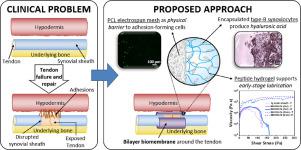Acta Biomaterialia ( IF 9.7 ) Pub Date : 2020-11-13 , DOI: 10.1016/j.actbio.2020.11.017 Angela Imere , Cosimo Ligorio , Marie O'Brien , Jason K.F. Wong , Marco Domingos , Sarah H. Cartmell

|
The repair of tendon injuries is often compromised by post-operative peritendinous adhesions. Placing a physical barrier at the interface between the tendon and the surrounding tissue could potentially solve this problem by reducing adhesion formation. At present, no such system is available for routine use in clinical practice. Here, we propose the development of a bilayer membrane combining a nanofibrous poly(ε-caprolactone) (PCL) electrospun mesh with a layer of self-assembling peptide hydrogel (SAPH) laden with type-B synoviocytes. This bilayer membrane would act as an anti-adhesion system capable of restoring tendon lubrication, while assisting with synovial sheath regeneration. The PCL mesh showed adequate mechanical properties (Young's modulus=19±4 MPa, ultimate tensile stress=9.6±1.7 MPa, failure load=0.5±0.1 N), indicating that the membrane is easy to handle and capable to withstand the frictional forces generated on the tendon's surface during movement (~0.3 N). Morphological analysis confirmed the generation of a mesh with nanosized PCL fibres and small pores (< 3 μm), which prevented fibroblast infiltration to impede extrinsic healing but still allowing diffusion of nutrients and waste. Rheological tests showed that incorporation of SAPH layer allows good lubrication properties when the membrane is articulated against porcine tendon or hypodermis, suggesting that restoration of tendon gliding is possible upon implantation. Moreover, viability and metabolic activity tests indicated that the SAPH was conducive to rabbit synoviocyte growth and proliferation over 28 days of 3D culture, sustaining cell production of specific matrix components, particularly hyaluronic acid. Synoviocyte-laden peptide hydrogel promoted a sustained endogenous production of hyaluronic acid, providing an anti-friction layer that potentially restores the tendon gliding environment.
中文翻译:

工程化一种细胞-水凝胶-纤维复合材料,以模仿肌腱滑膜鞘的结构和功能
肌腱损伤的修复通常受到术后腹膜粘连的损害。在肌腱和周围组织之间的界面处放置物理屏障可以通过减少粘连形成来潜在地解决此问题。目前,没有这样的系统可用于临床实践中的常规使用。在这里,我们提出了一种双层膜的开发,该膜结合了纳米纤维聚(ε-己内酯)(PCL)电纺网和一层带有B型滑膜细胞的自组装肽水凝胶(SAPH)。该双层膜将充当能够恢复腱润滑的抗粘附系统,同时有助于滑膜鞘的再生。PCL网片具有足够的机械性能(杨氏模量= 19±4 MPa,极限拉应力= 9.6±1.7 MPa,破坏载荷= 0.5±0.1 N),表示该膜易于处理并且能够承受运动过程中在肌腱表面产生的摩擦力(约0.3 N)。形态学分析证实了具有纳米PCL纤维和小孔(<3μm)的网孔的产生,这阻止了成纤维细胞的渗透以阻止外在愈合,但仍允许营养物和废物的扩散。流变测试表明,当将膜与猪腱或皮下组织铰接时,结合SAPH层可提供良好的润滑性能,这表明在植入时可以恢复腱滑行。此外,活力和代谢活性测试表明,SAPH有助于兔滑膜细胞在3D培养28天中的生长和增殖,从而维持特定基质成分的细胞产生,特别是透明质酸。富含滑膜细胞的肽水凝胶促进了透明质酸的持续内源性产生,提供了一个抗摩擦层,可以潜在地恢复腱滑行环境。



























 京公网安备 11010802027423号
京公网安备 11010802027423号